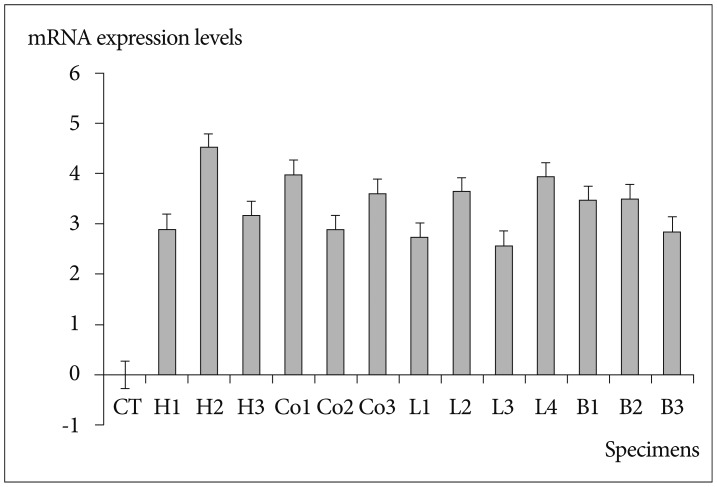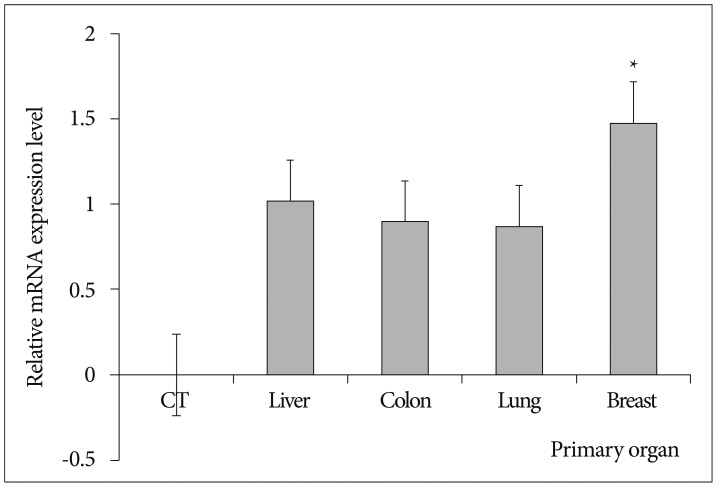J Korean Neurosurg Soc.
2015 May;57(5):329-334. 10.3340/jkns.2015.57.5.329.
Overexpressions of Vimentin and Integrins in Human Metastatic Spine Tumors
- Affiliations
-
- 1Department of Neurosurgery, Seoul National University Boramae Medical Center, Seoul, Korea.
- 2Department of Pathology, Kangwon National University School of Medicine, Chuncheon, Korea.
- 3Department of Neurosurgery, Seoul National University College of Medicine, Seoul, Korea. chungc@snu.ac.kr
- 4Department of Brain and Cognitive Sciences, Seoul National University College of Natural Sciences, Seoul, Korea.
- 5Clinical Research Institute, Seoul National University Hospital, Seoul, Korea.
- KMID: 1881729
- DOI: http://doi.org/10.3340/jkns.2015.57.5.329
Abstract
OBJECTIVE
To comparatively investigate the expression of several integrins in specimens of human bone metastases and degenerative bone tissue.
METHODS
Degenerative cancellous tissue was obtained from a sample of human degenerative spine. Thirteen human specimens were obtained from metastatic spine tumors, whose primary cancer was colon cancer (n=3), hepatocellular cancer (n=3), lung cancer (n=4), and breast cancer (n=3). The expression of vimentin and integrins alphav, beta1, and beta3 was assessed in metastatic and degenerative specimens by immunohistochemistry and real-time reverse transcription-polymerase chain reaction (qRT-PCR).
RESULTS
Immunohistochemical staining showed that vimentin and integrin alphav was broadly expressed in all tissues examined. By contrast, integrin beta1 was weakly expressed only in 38.4% (5/13) of tissues. Integrin beta3 was consistently negative in all cases examined. qRT-PCR analysis showed that vimentin gene expression was higher in all metastatic specimens, as compared to degenerative bone. The gene expression of integrin alphav in breast specimen was significantly higher than others (p=0.045). The gene expression of integrin beta1 was also higher in all metastatic specimens than in degenerative bone tissue. The gene expression of integrin beta3 was variable.
CONCLUSION
Spinal metastatic tumors have mesenchymal characteristics such as increased expression of vimentin. The increased expression of integrin alphav and beta1 in spine metastatic tumors suggests that adhesive molecules such as integrin may have implications for the prevention of spine metastasis.
Keyword
MeSH Terms
Figure
Reference
-
1. Clëzardin P. Integrins in bone metastasis formation and potential therapeutic implications. Curr Cancer Drug Targets. 2009; 9:801–806. PMID: 20025568.
Article2. Coghlin C, Murray GI. Current and emerging concepts in tumour metastasis. J Pathol. 2010; 222:1–15. PMID: 20681009.
Article3. Edlund M, Miyamoto T, Sikes RA, Ogle R, Laurie GW, Farach-Carson MC, et al. Integrin expression and usage by prostate cancer cell lines on laminin substrata. Cell Growth Differ. 2001; 12:99–107. PMID: 11243469.4. Engebraaten O, Trikha M, Juell S, Garman-Vik S, Fodstad Ø. Inhibition of in vivo tumour growth by the blocking of host alpha(v)beta3 and alphaII(b)beta3 integrins. Anticancer Res. 2009; 29:131–137. PMID: 19331142.5. Gudadze M, Kankava K, Mariamidze A, Burkadze G. Distribution of cancer stem cells in ductal invasive carcinoma of breast (review). Georgian Med News. 2013; (222):44–50. PMID: 24099814.6. Hauschka PV, Mavrakos AE, Iafrati MD, Doleman SE, Klagsbrun M. Growth factors in bone matrix. Isolation of multiple types by affinity chromatography on heparin-Sepharose. J Biol Chem. 1986; 261:12665–12674. PMID: 3745206.
Article7. Ivaska J. Vimentin : central hub in EMT induction? Small GTPases. 2011; 2:51–53. PMID: 21686283.8. Jung KW, Won YJ, Kong HJ, Oh CM, Seo HG, Lee JS. Cancer statistics in Korea : incidence, mortality, survival and prevalence in 2010. Cancer Res Treat. 2013; 45:1–14. PMID: 23613665.
Article9. Mallini P, Lennard T, Kirby J, Meeson A. Epithelial-to-mesenchymal transition : what is the impact on breast cancer stem cells and drug resistance. Cancer Treat Rev. 2014; 40:341–348. PMID: 24090504.
Article10. Patel LR, Camacho DF, Shiozawa Y, Pienta KJ, Taichman RS. Mechanisms of cancer cell metastasis to the bone : a multistep process. Future Oncol. 2011; 7:1285–1297. PMID: 22044203.11. Qin J, Vinogradova O, Plow EF. Integrin bidirectional signaling : a molecular view. PLoS Biol. 2004; 2:e169. PMID: 15208721.13. Schneider JG, Amend SR, Weilbaecher KN. Integrins and bone metastasis : integrating tumor cell and stromal cell interactions. Bone. 2011; 48:54–65. PMID: 20850578.
Article14. Sethi S, Macoska J, Chen W, Sarkar FH. Molecular signature of epithelial-mesenchymal transition (EMT) in human prostate cancer bone metastasis. Am J Transl Res. 2010; 3:90–99. PMID: 21139809.15. Shen Z, Ye Y, Kauttu T, Seppänen H, Vainionpää S, Wang S, et al. Novel focal adhesion protein kindlin-2 promotes the invasion of gastric cancer cells through phosphorylation of integrin β1 and β3. J Surg Oncol. 2013; 108:106–112. PMID: 23857544.
Article16. Sloan EK, Pouliot N, Stanley KL, Chia J, Moseley JM, Hards DK, et al. Tumor-specific expression of alphavbeta3 integrin promotes spontaneous metastasis of breast cancer to bone. Breast Cancer Res. 2006; 8:R20. PMID: 16608535.17. Sterling JA, Edwards JR, Martin TJ, Mundy GR. Advances in the biology of bone metastasis : how the skeleton affects tumor behavior. Bone. 2011; 48:6–15. PMID: 20643235.
Article18. Tsai JH, Yang J. Epithelial-mesenchymal plasticity in carcinoma metastasis. Genes Dev. 2013; 27:2192–2206. PMID: 24142872.
Article19. Tsuji T, Ibaragi S, Hu GF. Epithelial-mesenchymal transition and cell cooperativity in metastasis. Cancer Res. 2009; 69:7135–7139. PMID: 19738043.
Article20. van den Hoogen C, van der Horst G, Cheung H, Buijs JT, Pelger RC, van der Pluijm G. Integrin αv expression is required for the acquisition of a metastatic stem/progenitor cell phenotype in human prostate cancer. Am J Pathol. 2011; 179:2559–2568. PMID: 21907176.
Article21. van der Horst G, van den Hoogen C, Buijs JT, Cheung H, Bloys H, Pelger RC, et al. Targeting of αv-integrins in stem/progenitor cells and supportive microenvironment impairs bone metastasis in human prostate cancer. Neoplasia. 2011; 13:516–525. PMID: 21677875.
Article22. van der Pluijm G. Epithelial plasticity, cancer stem cells and bone metastasis formation. Bone. 2011; 48:37–43. PMID: 20670698.
Article23. van der Pluijm G, Sijmons B, Vloedgraven H, Deckers M, Papapoulos S, Löwik C. Monitoring metastatic behavior of human tumor cells in mice with species-specific polymerase chain reaction : elevated expression of angiogenesis and bone resorption stimulators by breast cancer in bone metastases. J Bone Miner Res. 2001; 16:1077–1091. PMID: 11393785.
Article24. Vuoriluoto K, Haugen H, Kiviluoto S, Mpindi JP, Nevo J, Gjerdrum C, et al. Vimentin regulates EMT induction by Slug and oncogenic H-Ras and migration by governing Axl expression in breast cancer. Oncogene. 2011; 30:1436–1448. PMID: 21057535.
Article25. Yamashita N, Tokunaga E, Kitao H, Hisamatsu Y, Taketani K, Akiyoshi S, et al. Vimentin as a poor prognostic factor for triple-negative breast cancer. J Cancer Res Clin Oncol. 2013; 139:739–746. PMID: 23354842.
Article
- Full Text Links
- Actions
-
Cited
- CITED
-
- Close
- Share
- Similar articles
-
- Relationship between Vimentin Expression and Progression of Uterine Cervix Epithelial Neoplasms
- Tumors of the Spine
- Immunohistochemical Staining of Ovarian Tumors
- Unstable Cervical Spine Caused by Metastatic Tumors
- Effect of Cytokines on Expression of Intercellular Adhesion Molecule - 1 in Nasal Epithelial Cells




